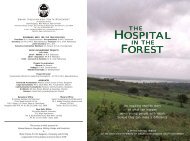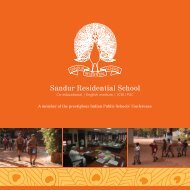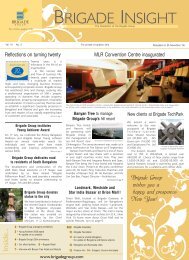Varna Mythri
Varna Mythri
Varna Mythri
- No tags were found...
You also want an ePaper? Increase the reach of your titles
YUMPU automatically turns print PDFs into web optimized ePapers that Google loves.
17c. Edward L. Smith17d. K. G. Subramanyanall other art forms . . . So the time has come for artists tothink about their future”. Rumale is not referring to theartists’ economic conditions here. He adds, “We are atcrossroads in the field of art. It is necessary to nurture everyart form that is essential for the cultural development ofthe State. Moreover, the self-absorbed art forms must bediscouraged. No one form must be allowed to dominate.”The artists generally believed that it was the responsibilityof the artist to prepare his/her audience. They madeconsiderable efforts in that direction, enlisting also themedia for support. However, the few reporters and freelancewriters who wrote on music, dance or art had no directinfluence on the public, nor could they adequately articulatethe artists’ specific persuasions.These were the conditions of modernity in whichRumale set out to create and cultivate his audience(see Appendix). He invited people to visit his Galleryand gathered their opinions in a visitor’s book which hecherished (Fig. 17a to d). The book provides a range ofresponses reflecting the aesthetic and ideological outlookof his audience between 1960 and 1988, the period duringwhich Rumale was fully engaged in art practice. The visitorsincluded distinguished artists, administrators and politicalleaders, who recorded their impressions, possibly at theartist’s request. Obviously, Rumale was not a self-absorbed orreclusive artist. He was serious about his social commitmentsas well as deeply drawn to spiritual concerns. He initiatedseveral institutional changes that have enriched our culturallife. He modestly described his contributions to the artfield as a seve (humble service). He believed that the ‘fires’of the freedom struggle would not only purify him, but alsowould strengthen and invigorate his art. He writes, “A trueartist has to go through the litmus test of the IndependenceMovement. If I can do that, my art and writings will turnout to be more vital” (Fig. 18). Hadapad, in his tributetelecast on Dooradarshan a few days after the artist’s death,described Rumale as a margadarshi kalavidaru (the artist whoshows the ‘Way’) (Fig. 19). This is high praise indeed, butbefitting an artist who had a vision for the place of art inthe public domain.In search of a methodRumale was preoccupied with an appropriate method ordirection in art and life, from a young age. Apart fromexpressing certain practical difficulties in training himself, hehas not specified in his writings what constituted a methodfor him. It is in his approach to painting that we discover afew leads suggesting that the means were as important forhim as the ends. Although a simple man in his personallife, Rumale loved to work with the best of materials andonly used specific imported brands of paint. One of theelements of his art practice, recalled frequently by the artistswho knew him, was his preference for ‘distilled water’ forwatercolour painting, instead of tap water. In addition to the‘purity’ of the medium, the manner in which he maintainsthe colour identities of the pigments and their transparency17. A few extracts from the visitor’s book maintained by the artist in his Gallery. 18. Rumale Chennabasaviah, the Autobiographical Note, p. 530 <strong>Varna</strong> <strong>Mythri</strong>The Art of Rumale Chennabasaviah31
44 45
Untitledc 1960, Pencil and Pen on paper, 36 x 56 cm, COLLECTION Rumale Art GalleryUntitledc 1970, Pen on paper, 25.5 x 34 cm, COLLECTION Rumale Art Gallery46 47
Rumale embraces the sensory stimuli throughforms, shapes, colours and textures. He takes everypossible opportunity to record his encounters outdoorsinvolving secular and religious motifs, manmadefountains and the natural vegetation etc. But he is notinterested in the momentary aspects of nature. Lightis essential but the shadows are incidental. Humanpresence is limited to a few coloured dabs.Through certain still and dynamic forms, rigidand playful shapes, controlled and liberated brushwork,he foregrounds a profound tension. All action isstilled – no flying birds, wind-swept trees, or morphingclouds. Big and small, ordinary and the rare – allof nature’s variety appear to transcend the fleetingto signify a more lasting if not an eternal value thatthe artist seeks in nature. Rumale’s paintings reflect adynamic equilibrium through his meditative approach.56 57
Tree in Bloom, K. R. Circle [Bangalore]1983, Watercolour on paper, 28.5 x 39 cm, COLLECTION Rumale Art GalleryK. R. Circle, Bangalore—A Collage1979, Watercolour on paper, 66 x 98.5 cm, COLLECTION Rumale Art Gallery62 63
Immediately on completion of his ‘Higher Exams’in art from Kalamandira in 1930, Rumale joinedthe Satyagraha movement, much against the wishesof his elders. Sacrificing a successful public life in hisearly sixties, later, he embarked on a course of intenseself-study in painting. Besides learning from variousmanuals and making copies of European artists’ works,he also began to paint directly from nature.Regularly painting outdoors, the artist sought outspecific places, especially in Bangalore. He would thenwork on the spot, building up his image slowly andreturning to the scene day after day, till he completedthe picture. He was very careful about the conditionsof light and took care to maintain consistency byworking at the same time every day. The changes innature were not important for his particular artisticpersuasions.70 71
Unknown Soldier Statue, opposite GPO, Bangalore1978, Oil on canvas, 37.5 x 57.5 cm, COLLECTION Rumale Art GalleryGul Mohur and Bamboo Grove, Cubbon Park [Bangalore]1984, Oil on canvas, 39 x 49 cm, COLLECTION Rumale Art Gallery74 75















